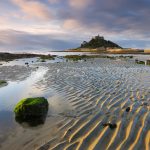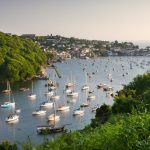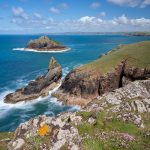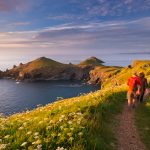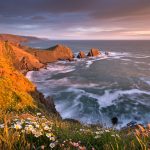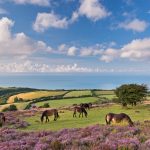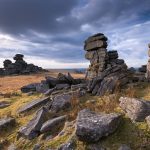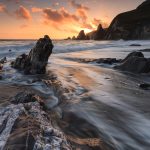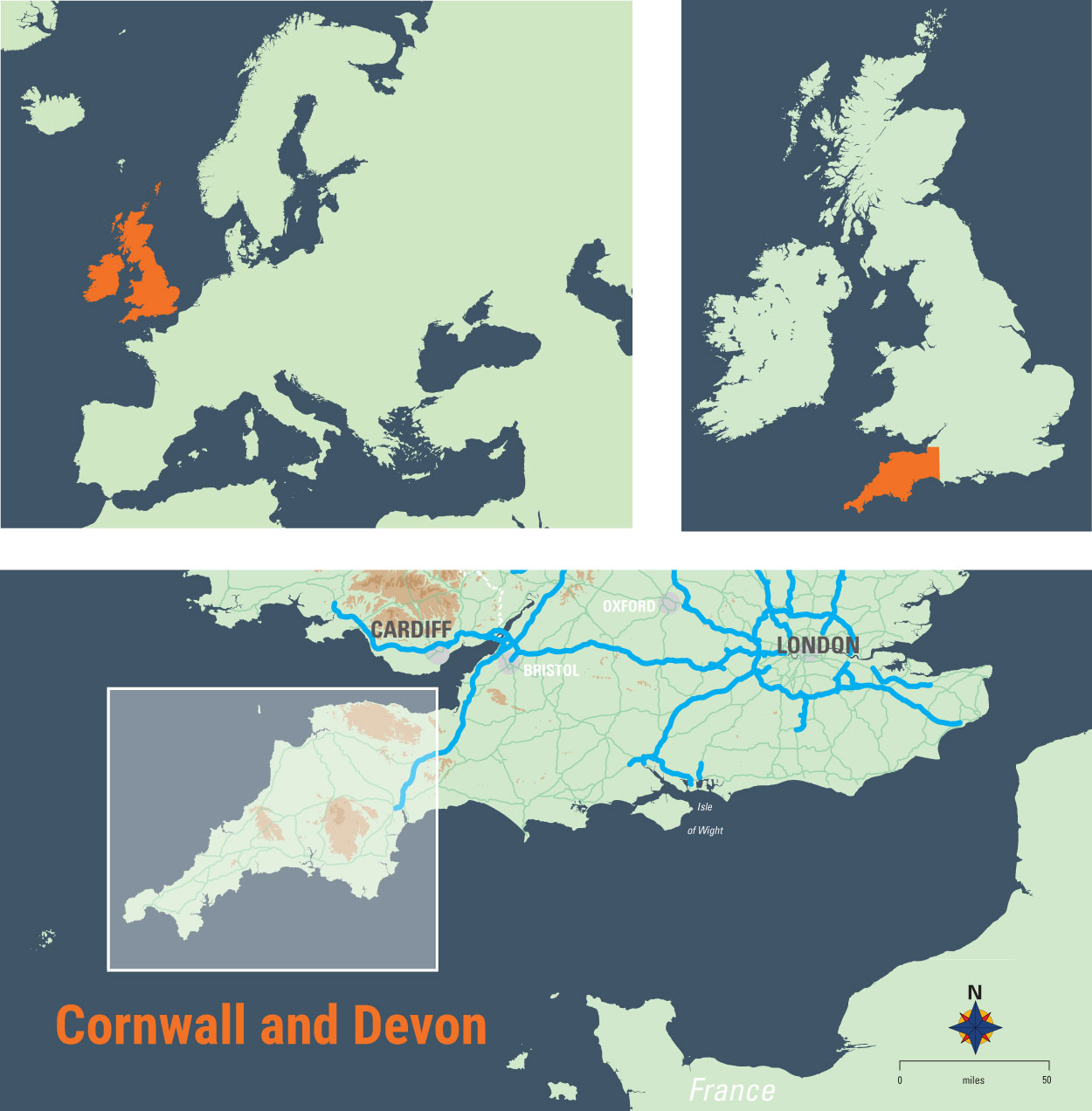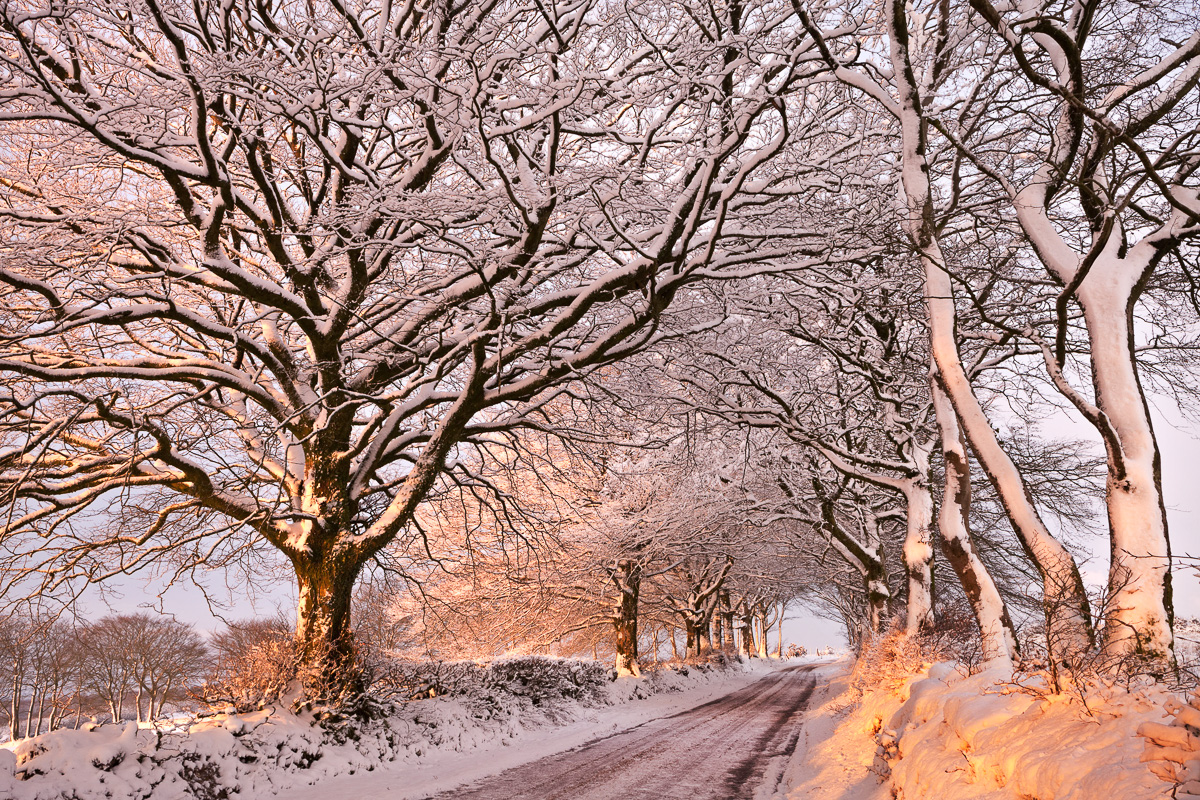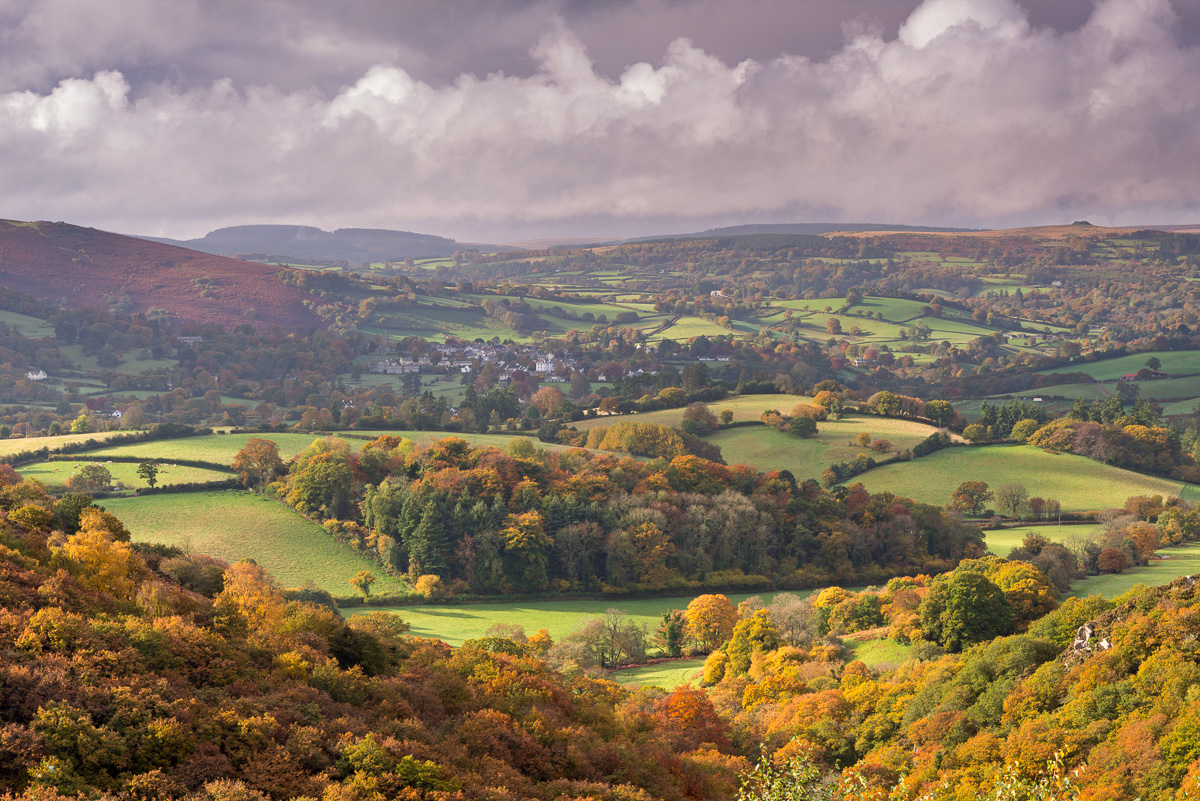With much of the UK’s most spectacular coastline, together with endless rolling hills of patchwork countryside and the high moorland of Exmoor and Dartmoor, Cornwall and Devon are renowned for their beautiful landscapes and are rich with photographic potential.
Whether you are looking for beach or cliff top views, moorland, river or forest, the tremendous variety of landscapes in the South West will inspire you when visiting with your camera, regardless of the season.
Below are some highlights from the area to whet your appetite.
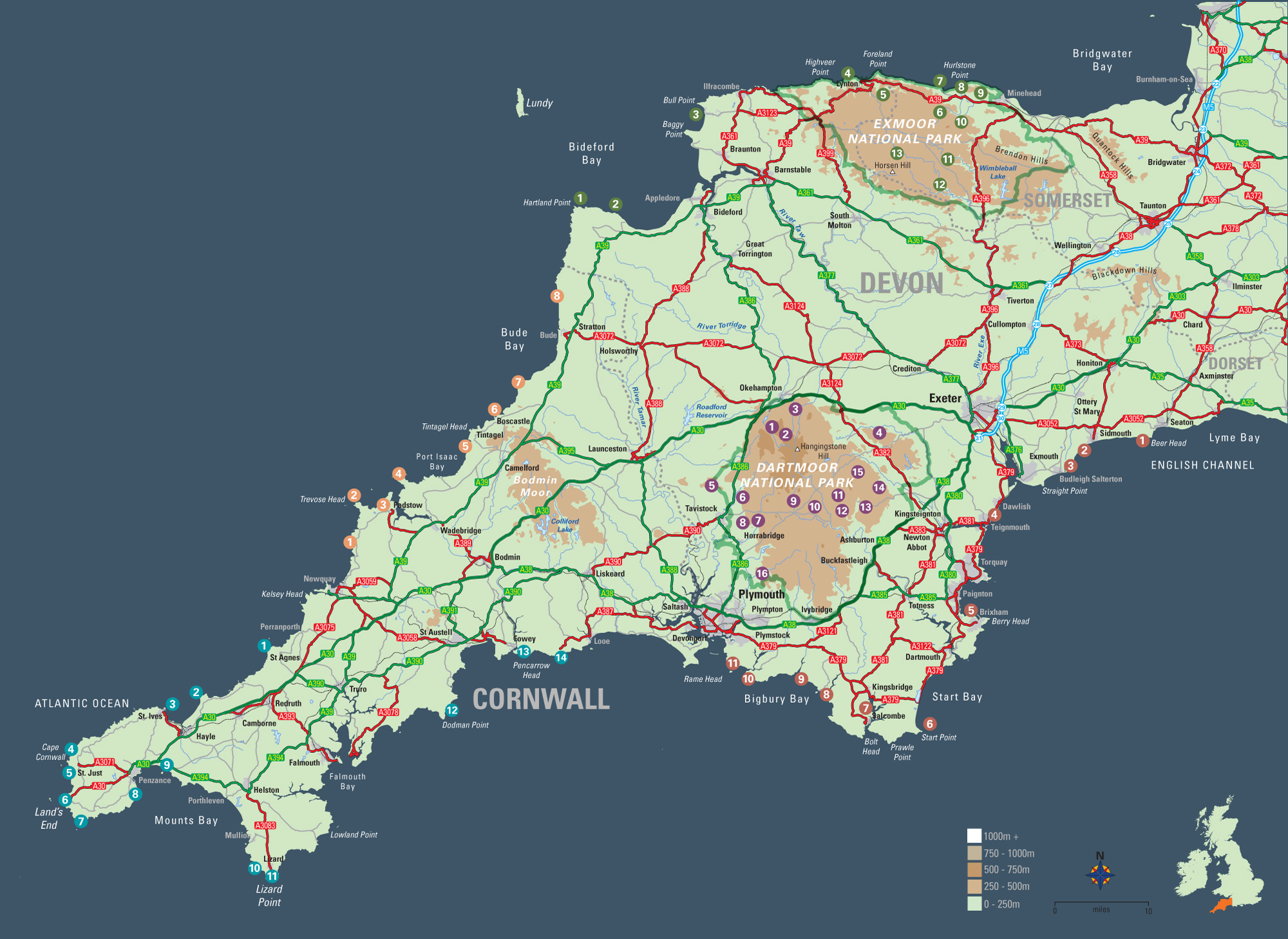
Cornwall
West and South Cornwall
As you approach the westernmost tip of the Cornish peninsula, the picturesque landscape takes on a wilder and more windswept appearance. The land splits into two peninsulas, Penwith and the Lizard, each facing the full force of the Atlantic. The Penwith peninsula is home to two of Cornwall’s most famous landmarks; Land’s End and St Michael’s Mount, both locations high on the list for visitors to the county.
The coast throughout this area is spectacular and always dramatic, with soaring granite cliffs facing angry Atlantic waves. Away from the rugged cliffs, some of Cornwall’s most beautiful golden sandy beaches can be found at Porth Leven, Sennen Cove and all around St Ives.
Further south, the geology of the Lizard peninsula is quite unlike Penwith’s blocky granite coast.The rocks here are mostly serpentinite, giving the cliffs a distinctive jagged appearance. Notable locations along this stretch of coastline are the beautiful National Trust owned Kynance Cove and nearby Mullion Cove, as well as Lizard Point, the most southerly point of mainland Great Britain.
After rounding the Lizard, the south coast begins its long journey north east towards the border of Devon. Although dramatic cliffs and headlands occur all throughout the south coast, generally speaking it has a much softer feel than the exposed Atlantic coastline. Large estuaries and pretty coastal towns such as Fowey, Mevagissey and Polperro add extra flavour to Cornwall’s distinctive south coast.
- Overlooking Pednvounder Beach from the cliff top footpath, Canon 1Ds Mark III, 16-35mm at 20mm, ISO 100, 1/8 sec at f/16. October. © Adam Burton
- St Michael’s Mount. Rippled sand and tidal pools revealed at low tide, Canon 1Ds Mark III, 16-35mm at 20mm, ISO 50, 8 sec at f/16. October . © Adam Burton
- Unusually high levels of sand cover Porth Nanven’s distinctive boulders, Canon 1Ds Mark III, 16-35mm at 20mm, ISO 100, 200 sec at f/16. October. © Adam Burton.
- Yachts moored in Pont Pill with Polruan beyond, Nikon D800, 70-200mm at 95mm, ISO 100, 1/20 sec at f/11. May. © Adam Burton.
North Cornwall
Dramatic cliffs, crashing Atlantic waves and pristine sandy beaches; these are the ingredients that make North Cornwall one of the UK’s most spectacular coastal locations.
The beaches along the seaside of North Cornwall draw visitors every summer, eager to enjoy the sun and surf that this coastline offers in abundance. From Bude near the Devon border down to Newquay and beyond every beach is a winner for both holidaymakers and photographers alike, consisting of golden sands and dramatic cliffs.
Without question one of North Cornwall’s most photogenic locations is the stretch of coastline between charming Padstow and its noisier neighbour Newquay. Around Trevose Head alone no less than seven glorious sandy beaches can be found, the difficulty for any visitor is choosing which beach to visit.
Away from the beaches, the cliffs are no less spectacular and thanks to the South West Coast Path are freely accessible to visitors. One highlight of this area is the incredible Bedruthan Steps, a dramatic series of rock stacks running parallel to the cliffs. At high tide these stacks take a pounding from the fierce Atlantic rollers, while at low tide they become stranded on one of the most beautiful beaches to be found anywhere.
In a county renowned for its tin mining past, the Towanroath Engine House at Wheal Coates is perhaps the most iconic and recognisable reminder of Cornwall’s mining heritage. This abandoned building, now preserved by the National Trust, guards the cliff tops overlooking the Atlantic and is the subject of countless iconic Cornish postcards.
- CAPTION: Seven Souls Rock and The Mouls, Nikon D800E, 17- 35mm at 24mm, ISO 50, 8 sec at f/14. May. © Adam Burton
- Walkers on the South West Coast Path overlooking the Rumps, Nikon D800E, 17-35mm at 20mm, ISO 200, 0.4 sec at f/11. June. © Adam Burton
- Jagged upright ledges at Duckpool, Canon 1Ds Mark III, 16-35mm at 25mm, ISO 100, 8 sec at f/16. March. © Adam Burton
- Tranquil morning overlooking Padstow harbour, Nikon D800E, 24-70mm at 36mm, ISO 100, 1.3 sec at f/11. June © Adam Burton
Devon
North Devon Coast and Exmoor
Devon’s north coast shares many similarities with neighbouring Cornwall; sweeping sandy beaches and towering cliffs are to be found in abundance along this coast. Away from the towns this area has the same wild remoteness that is to be found all along the Atlantic coast, and forms a large part of its appeal.
Our chapter begins with the incredibly rugged Hartland Quay close to the Cornish border, and then sweeps around the coastline following some beautiful beaches before reaching Exmoor. At Exmoor, things change quite suddenly and dramatically. Although already high, the cliffs surge upwards making them the highest cliffs in England. With such high cliffs and fewer openings to the sea, much of the Devon stretch of the Exmoor coast is the remotest in England. Eventually, Devon gives way to Somerset and before long a wide pebble beach at beautiful Porlock Bay replaces the towering headlands of before.
Although one of the UK’s least visited national parks Exmoor surely boasts some of the greatest variety. As well as its incredible coastline the National Park, which straddles both Devon and Somerset, is famous for rolling moorland, idyllic rural countryside and wooded combes. Although being fairly close in proximity to neighbouring Dartmoor, the national parks bear little similarity. Exmoor features far larger areas of rolling countryside, and while it still contains large areas of moorland the distinctive heather covered hogsback hills have no granite tors in sight.
- Sea pink wildflowers on the cliffs above Screda Point, Nikon D800E, 17-35mm at 20mm, ISO 100, 6 sec at f/14. May. © Adam Burton Point, Devon, England. Spring (May) 2013. © Adam Burton
- Exmoor ponies and a carpet of flowering heather on Porlock Common, Nikon D800E, 17-35mm at 32mm, ISO 200, 1/40 sec at f/13. August. © Adam Burton
Dartmoor
At over 350 square miles, Dartmoor National Park contains southern England’s largest remaining area of wilderness. The landscape is most famous for its vast areas of windswept rolling moorland, crested by hundreds of remote granite outcrops known as tors. This dark brooding landscape with its dramatic weather has for long been associated with many myths and legends; haunting tales of headless horseman, hell hounds and many stories of the Devil himself have made the moor an ominous location for superstitious visitors over the years. Taking inspiration from such legends, Arthur Conan Doyle’s famous novel, The Hound of the Baskervilles was largely based on Dartmoor.
Although Dartmoor is closely associated with its characteristic open moorland, the National Park includes a gentler side which may elude first time visitors; large areas of patchwork rolling countryside are interspersed with idyllic villages while fast moving rocky rivers rush through verdant deep wooded valleys.
While much of Dartmoor’s moorland is now remote and empty, evidence is spread all over the moor of previous human habitation. Megalithic stone circles, standing stones and stone rows can be found throughout the moor, as well as remains of Bronze Age settlements and smaller hut circles, all pointing to a time when the climate was far more forgiving than the present day. In fact Dartmoor contains the highest concentration of Bronze Age artefacts in Europe; put a pin anywhere on an Ordnance Survey map of Dartmoor and you will be close to some ancient remnants of the past.
- Foggy conditions inside Wistman’s Wood, Nikon D800E, 24-70mm at 55mm, ISO 100, 0.6 sec at f/13. October. © Adam Burton
- The classic view of Great Staple Tor facing west, Nikon D800E, 17-35mm at 22mm, ISO 100, 0.5 sec at f/11. January. © Adam Burton
South Devon
As with Cornwall, the south Devon coast is in large part much more gentle than its northern counterpart, and holds considerably more variety. From Plymouth on the Cornish border down to Start Point in the South Hams, the coastline is a strange mixture of both gentle estuaries and dramatic cliffs.
After rounding Start Point, the long shingle beach at Slapton Sands signals a change in both the nature and direction of the coastline. From here until reaching Exmouth, the coastline heads northwards taking in the hugely popular seaside towns of Paignton and Torquay then the lesser known Teignmouth and Dawlish. Orcombe Point in Exmouth marks the western end of the spectacular Jurassic Coast, Britain’s second natural World Heritage Site. The bright red cliffs found in this area such as at Sidmouth and Ladram Bay are characteristic of this coastline and date back to the Triassic period. Further along the coast, at Beer the cliffs change again both in colour and consistency, this time to white dating from the more recent Cretaceous period.
- Spectacular coastal scenery at Westcombe, Canon 5D, 17-40mm at 17mm, ISO 50, 0.4 sec at f/22. April. © Adam Burton
- View over the old harbour at Brixham from Southern Quay, Canon 1Ds Mark III, 24-70mm at 60mm, ISO 100, 0.3 sec at f/10. January. © Adam Burton
Getting To Cornwall and Devon
Cornwall and Devon are popular destinations in the summer, attracting millions of holidaymakers. As a result, there is a good network of major roads connecting them with the rest of the UK. Travelling around the area once you get there can be very slow, as the country lanes are very narrow.
From the North and East
Visitors to the South West will usually arrive by one of two roads. The majority of people travelling from the north will take the M5 which runs from Birmingham all the way to Exeter in Devon. Those travelling from the east may also join the M5 at Bristol, or alternatively travel along the A303/A30 before it joins the M5 at Exeter. The M5 comes to an end just past Exeter, providing travellers with a choice of two A class dual carriageway roads depending on final destination. The A30 provides the main artery, running right through the centre of Devon all the way down to Land’s End at the very western tip of Cornwall. Those travelling to South Devon or South Cornwall, take the A38 towards Plymouth.
Distances and driving times to Exeter
Visitors to the South West will usually arrive by one of two roads. The majority of people travelling from the north will take the M5 which runs from Birmingham all the way to Exeter in Devon. Those travelling from the east may also join the M5 at Bristol, or alternatively travel along the A303/A30 before it joins the M5 at Exeter. The M5 comes to an end just past Exeter, providing travellers with a choice of two A class dual carriageway roads depending on final destination. The A30 provides the main artery, running right through the centre of Devon all the way down to Land’s End at the very western tip of Cornwall. Those travelling to South Devon or South Cornwall, take the A38 towards Plymouth.
| Origin | Distance | Time |
|---|---|---|
| Bristol via M5 | 80 miles | 1h 35 min |
|
Birmingham via M5 |
170 miles |
2h 50 min |
|
London via M4 and M5 |
197 miles |
3h 30 min |
|
Manchester via M6 and M5 |
241 miles |
4h 20 min |
|
Newcastle via A1(M) and M5 |
368 miles |
6h 15 min |
|
Glasgow via M74, M6 and M5 |
445 miles |
7h 15 min |
Where to stay
Both Visit Cornwall www.visitcornwall.com and Visit Devon www.visitdevon.co.uk are great places to start planning your trip to the South West.
Climate
The climate of the South West is typified by warm summers, cool winters and precipitation all year round. Cornwall and Devon benefit from being on the eastern edge of the warm Gulf Stream and towns such as St. Ives, Newquay and Ilfracombe have a Mediterranean climate with summer temperatures reaching 30 C (86F). Long days with up to 16 hours of sun mean that summers are great for coastal sunrise and sunset photography. However spring and autumn, or when there are summer storms around, will give that all important cloud on the horizon for the best golden hour photography. An important consideration is that both spring and autumn are not quite so challenging sleep-wise for golden hour photography. The north coast is generally best for sunsets and the south for sunrises.
Best Times of Year To Visit For Photography
Whilst the South West is good all year round for landscape photography there are some key times of the year.
Late May
Although the coast makes a wonderful place to photograph throughout the year, the best time to shoot from the cliff tops is late May. At this time, headlands all over the Cornish and Devon coastlines are covered in beautiful pink wildflowers. These delicate sea pinks, as well as other wildflowers such as bright yellow kidney vetch, add some lovely colour to foregrounds when shooting from cliff tops. Sunset and sunrise times are still respectable at this time.
August Heather
Exmoor especially is renowned for its heather-covered hills, making August one of the best months to visit the national park. Exmoor’s deep wooded combes come into their own during early summer before the lush foliage has faded to dull green. At this time, beautiful ferns spring up around fast flowing rocky streams, contributing to provide irresistible subject matter for woodland photographs. Water levels may be low at this time of year, so time your visit after rain to ensure the rivers and waterfalls are flowing well.
Autumn
Autumn is surely the best season for photography and it is a delightful time in the South West. Early autumn sometimes coincides with a sustained period of good weather, as the UK occasionally enjoys an Indian Summer. With the departure of summer holidaymakers the coast becomes peaceful, with empty beaches and quiet fishing harbours waiting to be photographed.
Sunrise comes later and sunset earlier as the day lengths shorten making landscape photography a more enjoyable experience. But it’s the quality of light that really makes autumn special. Gone is the haze of summer, now replaced by crisp clear days with excellent visibility. Similar to spring, the combination of cold nights and warm still days make September a perfect time to photograph mist-covered countryside.
Moving into October and early November, the landscape is about to undergo its most magnificent transformation of the year. Both national parks boast some incredible locations to photograph autumn colours. Deep wooded valleys with fast flowing rocky rivers such as Watersmeet in Exmoor and Fingle Bridge in Dartmoor make spectacular locations for photography during the autumn when mature deciduous trees overhanging the river banks are resplendent in golden foliage.



